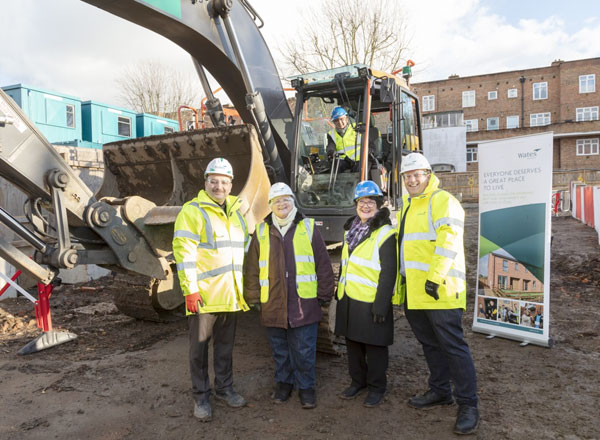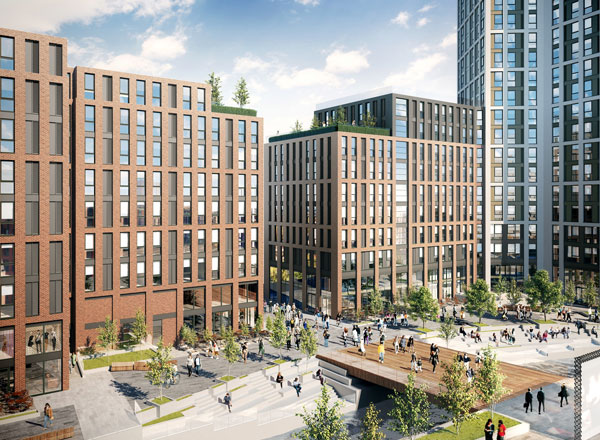Real Estate Management (UK) Limited (“REM”) and Sellar, the joint development manager, celebrated Shard Place, the third phase of development at Shard Quarter, reaching its highest point with a traditional construction topping out event. The 26-storey residential building stands between The Shard, Western Europe’s tallest building, and The News Building in London Bridge and will comprise of 176 apartments. The topping out event was led by Michael Baker, CEO of REM, and James Sellar, CEO of Sellar. They welcomed representatives from the project team, which includes architect Renzo Piano Building Workshop, construction managers Mace and project engineer WSP, and local dignitaries. To mark the event, a delegation travelled to the very top of the building to fill one final section with concrete using a ceremonial spade. Shard Place is the third phase of the £3.5 billion redevelopment of the estate next to London Bridge station, now known as Shard Quarter. The project team will now turn its attention to completing the cladding, which is in keeping with the aesthetics of The Shard and The News Building. The interior fit out has already commenced with the installation of high-quality fixtures and fittings. When completed in late 2020, Shard Place will provide a choice of studio, one, two and three-bedroom apartments alongside amenities for the exclusive use of residents including a cinema, spa, and private roof garden. The building will appear to ‘float’ nine metres above ground level providing 13,000 sq ft of public realm and circa 12,000 sq ft of retail space, further reinforcing Shard Quarter as one of London’s most vibrant communities. Residents will benefit from Shard Quarter’s exceptional transport links given its proximity to London Bridge Station. Alongside the onsite amenities, Shard Quarter is next door to world-famous cultural hotspots and historical locations, such as Borough Market, Bermondsey Street and Tower Bridge, making the area an attractive place to live, as well as work and visit. James Sellar, CEO, Sellar said: “In keeping with the now well-established Shard Quarter, this latest phase brings a residential building designed by a world class architectural team. Our joint venture with the State of Qatar is creating a beautiful building with apartments of the highest design standards. As well as creating an integrated lifestyle building with outstanding amenities and spectacular views across London, Shard Place completes our vision for a truly mixed-use development at London Bridge which we commenced development of in 2008. This latest phase reflects Qatar’s commitment to both The Shard Quarter and its confidence in London and the UK, as well as the continuing strength of the relationship between the two countries” Michael Baker, CEO, Real Estate Management (UK) Limited, said: “The vision for Shard Quarter was to create a mixed-use quarter where people could live, work and relax. Shard Place will make this a reality when the first residents move in towards the end of 2020. With London’s population projected to grow rapidly over the next 15 years, we know that there will be strong demand for well-located homes and we have chosen to satisfy the need for high quality apartments. Shard Place will offer its residents an enviable lifestyle with exclusive amenities within the building and one of London’s most vibrant neighbourhoods on their doorstep all a stone’s throw from a major transportation hub.” Gareth Lewis, Mace’s Chief Operating Officer for Construction, said: “Shard Place will be an iconic addition to the London skyline and a fitting conclusion to delivery of the Shard Quarter. It’s a project that Mace is very proud to be working on, having been involved in the delivery of the Shard Quarter from the very beginning. This topping out reflects a significant milestone on the journey to delivering this complex and challenging construction project.” Joost Moolhuijzen, Architect, Renzo Piano Building Workshop, said: “Topping out is always a great moment, you finally start to see what the building will become. Some of its secrets get unveiled. It tells us also that the name “Shard Place” is right: “Shard” as it really feels like an integral part of The Shard. “Place” as it shows that once the hoardings will disappear a great Public Realm will appear connecting the Shard Quarter Piazza with St Thomas Street, opening up a whole new pedestrian route.” REM AND SELLAR CELEBRATE SHARD PLACE “TOPPING OUT” AS 26-STOREY RESIDENTIAL BUILDING REACHES ITS HIGHEST POINT Shard Place is a 26-storey residential building owned by the State of Qatar and developed in joint venture with Sellar Comprising 176 well specified apartments, following practical completion in 2020 Shard Place marks the latest phase in a £3.5 billion redevelopment of the Shard Quarter and in conjunction with the team from Renzo Piano Building Workshop adds an iconic residential landmark next to the Shard














